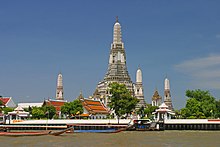Wat Arun
| Wat Arun | |
|---|---|
 | |
| Location | |
| Country | Thailand |
| Geographic coordinates | 13°44′38″N 100°29′19″E / 13.74389°N 100.48861°E |
Wat Arun Rajwararam (Thai: วัดอรุณ, Thai pronunciation: [wát ʔarun], "Temple of the Dawn") is a Buddhist temple (wat) in the Bangkok Yai district of Bangkok, Thailand, on the Thonburi west bank of the Chao Phraya River. The full name of the temple is Wat Arun Ratchawararam Ratchawaramahawihan (วัดอรุณราชวรารามราชวรมหาวิหาร). Named after Aruna, the Indian God of Dawn, the Wat Arun is considered one of the most well known of Thailand's many landmarks. Drawn on a novel by Japanese writer Yukio Mishima (The Temple of Dawn-The Sea of Fertility). The temple is so named because the first light of the morning reflects off the surface of the temple with pearly iridescence.[1] The monastery has existed for many years since the days when Ayutthaya was capital of Thailand. At the time named Wat Mokok, situated in a place called Tumbol Bangmakok. The word Bangmakok, meaning " Village of Olive", has since been shortened to "Makok".
History
The temple was originally known as Wat Chaeng. Originally it was located in the palace grounds and during the time of Rama I it moved to the other side of the river.[1] It was abandoned for a long period of time until Rama II, who restored the temple and extended the pagoda to 70m.[1] The Wat eshrined the emerald Buddha image before it was transferred to Bangkok in 1785 A.D. and it is believed that King Taksin vowed to restore the Wat after passing it one dawn.[2]
Architecture

The main feature of Wat Arun is its central prang (Khmer-style tower) which are encrusted with colourful porcelain.[3] This is interpreted as a stupa-like pagoda incrusted with coloured faience[4] The height is reported by different sources as between 66.8 m (219 ft) and 86 m (282 ft). The corners are surrounded by four smaller satellite prangs. The prangs are decorated by seashells and bits of porcelain which had previously been used as ballast by boats coming to Bangkok from China.[5] The presiding Buddha image, cast in the reign of Rama II, is said to have been moulded by the king himself. The ashes of King Rama II are buried in the base of the image.[6] Construction of the tall prang and four smaller ones was started by King Rama II during 1809-1824 A.D. and completed by King Rama III (1824–1851). The towers are supported by rows of demons and monkeys. Very steep and narrow steps lead to a balcony high on the central tower. The circumference of the base of the structure is 234 meters, and the central prang is 250 foot high.
The central prang is topped with a seven-pronged trident, referred to by many sources as the "Trident of Shiva".[7] Around the base of the prangs are various figures of ancient Chinese soldiers and animals. Over the second terrace are four statues of the Hindu god Indra riding on Erawan.[6] In the Buddhist iconography, the central prang is considered to have three symbolic levels - base for Traiphum indicating all realms of existence, middle for Tavatimsa where all desires are gratified and top denoting Devaphum indicating six heavens within seven realms of happiness.[6] At the riverside are six pavilions (sala) in Chinese style. The pavilions are made of green granite and contain landing bridges.

Next to the prangs is the Ordination Hall with a Niramitr Buddha image supposedly designed by King Rama II. The front entrance of the Ordination Hall has a roof with a central spire, decorated in coloured ceramic and stuccowork sheated in coloured china. There are two demons, or temple guardian figures, in front.[6] The murals were created during the reign of Rama V.[6]
Mythology
The central prang symbolizes Mount Meru of the Indian cosmology.[6] The satellite prangs are devoted to the wind god, Phra Phai. The demons (yaksha) at the entranceway to the ubosot are from the Ramakien. The white figure is named Sahassa Deja and the green one is known as Thotsakan, the Demon Rāvana from Ramayana.
Travel
Most of the tour packages around Bangkok offer a stop at Wat Arun, and it is an easy place to access by public transport. For the foreigners, the temple charges an entrance fee of THB 50 (as of September 2010). Wat Arun figures in one of Thailand's most colorful festival, the Royal Tod Kathin. The King travels down in a procession of Royal barges to present new robes to the monks after their three-month lent period.
Media
 |
 |
 |
 |
 |
 |
Notes
References
- Liedtke, Marcel (2011), Thailand- The East (English Edition), Norderstedt: Books on Demand GmbH, ISBN 978-3-8423-7029-6
{{citation}}: Cite has empty unknown parameter:|coauthors=(help) - Spooner, Andrew (2011), Footprint Thailand, UK: www.footprintbooks.com, ISBN 978-1-904777-946
{{citation}}: Unknown parameter|coauthors=ignored (|author=suggested) (help) - Ridout, Lucy (2009), The Rough Guide to Thailand's Beaches & Islands, India: Rough Guides, ISBN 978-7-84836-091-4
{{citation}}: Check|isbn=value: checksum (help); Unknown parameter|coauthors=ignored (|author=suggested) (help) - Norwich, John Julius (2001), Great architecture of the world, USA: De Capo Press Inc., ISBN 0-306-81042-5
{{citation}}: Cite has empty unknown parameter:|coauthors=(help) - Emmons, Ron (2008), Top 10 Bangkok, New York: DK, ISBN 978-0-7566-186-1
{{citation}}: Check|isbn=value: length (help); Cite has empty unknown parameter:|coauthors=(help)
External links
13°44′38″N 100°29′19″E / 13.74389°N 100.48861°E{{#coordinates:}}: cannot have more than one primary tag per page
